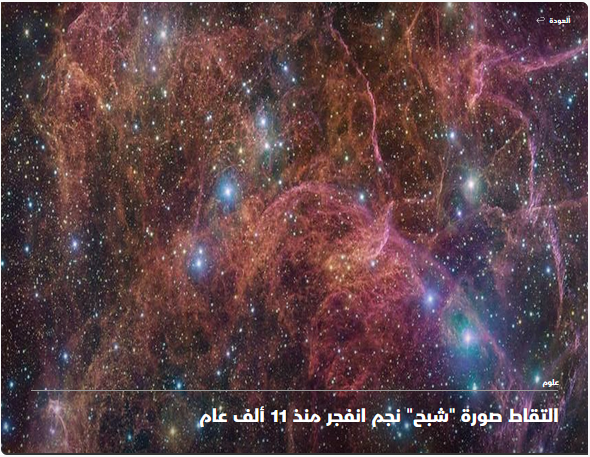Take a picture of the "ghost" of a star that exploded 11,000 years ago
Capturing a stunningly accurate image of the remnants of the "VPL" star, about 800 million light-years away from Earth. - European Southern Observatory
The lenses of the telescopes of the European Southern Observatory, located in Chile, captured a picture that scientists described as a "ghost" of the remnants of a "supernova" star called "Vebel", about 800 million light-years from Earth, and it exploded 11 years ago.
A "supernova" is an astronomical event that occurs during the death of stars, in which the center of the star begins to collapse in on itself and the star's body ejects its atmosphere into space to form a very bright spherical cloud around it.
The image shows a texture of colors for the ghostly remnants of the giant star. These colors result from the gaseous remnants of supernova explosions. The light of that explosion reached Earth about 11,000 years ago.
In addition to the colorful glowing gas streaks, that cosmic catastrophe left an incredibly dense stellar core.
This image also shows a wonderful view of the orange and pink clouds that form what remains after the explosive death of a massive star.
Picture Resolution
Composed of 554 million pixels, this detailed image is a mosaic of observations taken with the 268 million-pixel Omega Camera on the European Southern Observatory's VLT Survey Telescope.
The Omega camera can take pictures through several filters, each of which allows the telescope to see the emitted light in a distinctive color.
To capture this image, 4 filters were used, represented by a mixture of purple, blue, green, and red. The result was an extremely detailed and stunning display of both the gaseous filaments in the remnant and the bright blue stars that add luster to the image.
The delicate combination of pink and orange clouds is all that remains of the massive star that ended its life in a powerful explosion about 11,000 years ago.
When massive stars reach the end of their lives, they often self-destruct in an explosion called a supernova. What remains of the star is a very dense ball in which protons and electrons are pushed together to form neutrons, or what is known as a neutron star.
Outside the image taken in the upper left corner, the neutron star in the remains of "Phil" is a pulsar that rotates on its axis at an amazing speed of more than 10 times per second.
These explosions cause shock waves that move through the surrounding gas, compressing it and creating complex filament-like structures. The energy released heats the gas grid, causing it to shine brightly, as shown in this image.
This dramatic "supernova" remnant is one of the closest we know of.
When it exploded, the star's outer layers were expelled into the surrounding gas, producing amazing, colorful filaments documented by telescope lenses in that image.
The largest star in the universe is smaller than thought Al Sharq News
It turned out that the largest star observed in the universe is not the size that was previously estimated, as new observations showed, which is likely to apply to other stars. Al Sharq News
Source: websites




